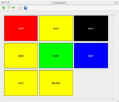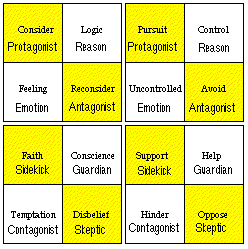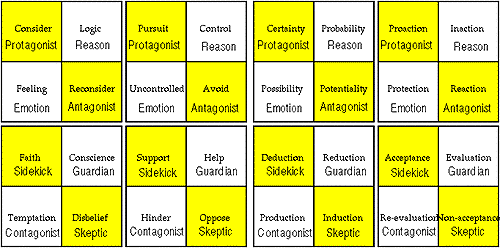|
|
Software |
StoryWeaver
$29.95

A step by
step approach to story development, from concept to completed story for
your novel or screenplay. More than 200 interactive Story Cards guide
you through the entire process.
Details
and Demo
Dramatica
$149.95

The most
powerful story structuring software available, Dramatica is driven by a
patented "Story Engine" that cross-references your dramatic
choices to ensure a perfect structure.
Details
and Demo
Movie
Magic Screenwriter
$149.95

The most
advanced screenwriting software available, Movie Magic is deemed a
"preferred file format" by the Writer's Guild. An industry
standard, MMS is used by professionals and studios around the world.
Details
and Demo
Throughline
Index Cards
$9.95

Interactive
index cards - Name them, add notes, titles, colors, click and drag to
re-arrange, adjust font, save, export and print. An essential tool for
every writer.
Details
Academic
Discounts
on Select Products

Are you a
student, teacher, or academic staffer? Get the very best price on select
products with these manufacturer sponsored academic discounts!
Details

|
| |
Chapter 9
Other Character Dimensions
-
What's the Purpose?
- When authors describe their characters, they are often asked to state a characters'
motivations. A common reply might be, "The character Jane wants to be
president." Often that is accepted as a valid motivation. In fact, becoming president
is Jane's Purpose, not her motivation. Her motivation may be that she felt
no control over her life as a child. Or she might be motivated by a love of the natural
world, hoping to instigate a national conservation plan. She might be motivated by a
desire for an equal rights amendment.
Just knowing what her purpose is does not tell us anything about what Jane is driven by
but only what she is driven toward. Any of the stated motivations would be
sufficient to explain Jane's purpose of becoming president. Conversely, if Jane's
motivation were the first example - a lack of control over her life as a child - several
different purposes might satisfy that motivation. She might become a school teacher, a
drill sergeant, or a religious leader. Clearly, motivations do not specifically dictate
purposes, nor are purposes indicative of any particular motivations.
Step into the Fourth Dimension....
- In Dramatica, we refer to Motivation as a Character Dimension. Often it is said that
characters must be three-dimensional to seem like real people. Dramatica sees four
dimensions as necessary to flesh out a character. Motivations and Purposes are the first
and last dimensions, but that is not enough. Motivation gives a character the force to
move, Purpose gives a character a direction in which to move. But how is he actually going
to get to where he wants to go? For this, he needs a Methodology, which is the third
dimension of character. Methodologies describe the kinds of approaches a character might
use in its efforts to achieve its purposes.
This might seem like enough dimensions. After all, we have a beginning (motivation), a
middle (methodology), and an end (purpose). Still, there is one remaining dimension
lacking: Evaluations. Evaluations are the standards by which characters measure their
progress.
-
All right, Buddy... Where's the conflict?!
- As an example of the concept of Evaluation, imagine two business partners who share
motivations, methodologies and purposes. They might agree on what drives them (a
motivation to be independent), what they want to achieve (a purpose of creating a thriving
business), and how to achieve that (word-of-mouth advertising as a methodology). Still,
they might argue if sales are up but satisfaction is low because one evaluates based on
gross sales and the other evaluates based on customer satisfaction. Their word-of-mouth
methodology brings in more business because their prices are good, but repeat business is
non-existent because of poor customer satisfaction. As a result, the two partners argue
all the time, even though they agree in all three dimensions of Motivation, Methodology,
and Purpose.
Difficulties can arise between characters in any one of the four dimensions, even though
they might agree completely in one or more of the other dimensions. In short, characters
are never fully developed unless they are represented in all four dimensions, and they may
come into conflict over any combination of Motivations, Methodologies, Means of
Evaluation, or Purposes.
-
The Sixty-Four Element Question
-
- Each of the character dimensions contains sixteen Elements, as we have already seen with
Motivations. Each character dimension is referred to as a Set of Elements. All four Sets
come together to create what is called a Chess Set (due to its eight by eight grid)
as illustrated below:

- A good way to get a feel for the content of and relationships between character
dimensions is through the Archetypal Characters. Beginning with the Motivation Set, when
we superimpose the Archetypal Characters onto the character Elements, an "archetypal
pattern" appears as follows:

-
Mapping the Archetypal Pattern
The archetypal pattern formed in the Motivation Set clearly illustrates the consistency
and balance of the character Elements. In each quad of four Elements, the items that are
diagonal from one another hold the greatest potential for conflict because they are exact
opposites.
For example, Pursuit is the opposite of Avoid. As a result, when we place the Protagonist
on the Motivation of Pursuit, we would expect the Antagonist to represent Avoid. As we
have illustrated in the previous section, that is exactly the case. Similarly, when we
place the Reason Archetype on Logic, it comes as no surprise to find Emotion residing on
Feeling, since it is diagonal from Logic. In fact, every pair of Archetypes that are in a
diagonal relationship will generate the greatest dynamics between them. This is why we
call two Elements in diagonal opposition a Dynamic Pair.

-
Archetypal Methodologies
Shifting our attention to the Methodology Set, a very useful thing becomes evident.
Because the Methodology Elements are also arranged in Dynamic Pairs, we can simply
duplicate the Archetypal pattern from the Motivation Set and the Archetypal Characters
will cover the Methods they represent in stories as well.

- For example, a Protagonist who is Motivated by Pursuit employs a Methodology of
Pro-action, and a Skeptic who is Motivated to Oppose employs a Methodology of
Non-Acceptance.
This Archetypal Pattern continues through all four character dimensions such that a
Protagonist will be motivated by Pursuit, employ a Methodology of Pro-action, Evaluate its
progress by the Effect it has, and strive toward achieving Actuality as its Purpose. Each
of the Archetypal Characters follows the same pattern for both its External and Internal
characteristics, resulting in an alignment of character Elements in four dimensions.
-
Complex Dimensional Patterns
Most stories tend to emphasize one dimension over the others. Character Motivations are
often made most prominent. Still, many stories are written that compare the methods used
by characters, question their purposes, or carry a message that a Means of Evaluation is
actually the cause of the problem. Some characters become famous for characteristics other
than Motivations, such as a notable detective who employs a methodology of Deduction.
Being aware of all four character dimensions adds a level of versatility in creating
complex characters as well. Characters might be Archetypal in one dimension, but fall into
complex patterns in another. Also, a character may have three Motivations that drive it,
yet strive toward a single Purpose that it hopes will satisfy all three. Some characters
may not be represented at all in one or more dimensions, making them both more complex and
less well-rounded at the same time. To fully make the argument of any story, however, all
sixty-four Elements must be represented in one character or another. In addition, a key
point to remember is: Unless a character represents at least one Element, it is not
fulfilling a dramatic function and is therefore being employed for storytelling only. -
What's In a Pair?
-
- Finally, we can use our Chess Set of Elements to learn something more about our
character's relationships. In each quad of Elements, we find not only Dynamic (diagonal)
Pairs, but horizontal and vertical pairs as well. Horizontal Elements are called Companion
Pairs, and vertical Elements are Dependent Pairs. Each kind of pair describes a different
kind of relationship between the Elements, and therefore between the characters that
represent them.
In addition to the three types of pairs, we can look at each Element as a separate
component and compare it to the overall nature of the quad itself. This Component approach
describes the difference between any given Element and the family of Elements in which it
resides (quad). Therefore, the degree of individuality the characters represent within the
"group" can be explored.


- Dynamic Pairs describe Elements with the greatest opposition to one another.
Whenever two opposing forces come together they will create either a positive or negative
relationship. They can form a synthesis and create something greater than the sum
of the parts or they can simply tear away at each other until nothing is left (destructive).
Within a quad, one of the Dynamic Pairs will indicate a positive relationship, the other a
negative one. Which is which depends upon other story dynamics.
Companion Pairs contain the Elements that are most compatible. However, just being
compatible does not preclude a negative relationship. In a positive Companion Pair,
characters will proceed along their own paths, side by side. What one does not need they
will offer to the other (positive impact). In a negative Companion Pair, one
character may use up what the other needs. They are not against each other as in a
negative Dynamic Pair, but still manage to interfere with each other's efforts (negative
impact).
Dependent Pairs are most complementary. In a positive sense, each character
provides strengths to compensate for the other's weaknesses (cooperation). Together
they make a powerful team. In its negative incarnation, the Dependent Pair Relationship
has each character requiring the other in order to proceed (codependency).
Components describe the nature of the Elements in relationship to the overall quad.
On the one hand, the individual characters in a quad can be a group that works together (interdependency).
The group is seen to be greater than the individual characters that comprise it, at the
risk of overwhelming the individuality of its members. This is contrasted by identifying
the disparate nature of each character in the quad (independency). Seen this way,
the characters are noted for their distinguishing characteristics at the risk of losing
sight of shared interests.
Dynamic Relationships are the most familiar to writers, simply because they generate the
most obvious kind of conflict. Companion and Dependent Pairs are used all the time without
fanfare, as there has previously been no terminology to describe them. Components are
useful to writers because they allow characters in groups to be evaluated in and out of
context.
By constructing characters with thought and foresight, an author can use the position of
Elements in the Chess Set to forge relationships that are Dynamic in one dimension while
being Companion and Dependent in others. Characters created with Dramatica can represent
both the structural Elements of the Story Mind's problem solving techniques and the
dynamic interchange between those techniques.
-
Summary
- Altogether we have outlined four dimensions of characteristics, each fostering an aspect
of the eight Archetypes. Each of the Archetypes can be sub-divided into internal and
external Elements resulting in a total of sixteen Elements in each dimension -- a total of
sixty-four characteristics from all four dimensions with which to build characters.
Complex character can be created by stepping out of the archetypal patterns and
relationships.
-
How to Order your copy of
Dramatica: A New Theory of Story
Back to the Table of Contents
Back to Home Page
Copyright 1996, Screenplay Systems, Inc.
The Dramatica theory was developed by Melanie Anne Phillips and Chris Huntley
Chief Architect of the Dramatica software is Stephen
Greenfield
Dramatica is a registered trademark of Screenplay Systems Incorporated
Visit
the Dramatica Theory Home Page
Try Dramatica & StoryWeaver Risk
Free*

$179.95
$29.95
*Try either or both for 90 days. Not working for you?
Return for a full refund of your purchase price!
About Dramatica and
StoryWeaver
Hi, I'm Melanie Anne Phillips,
creator of StoryWeaver,
co-creator of Dramatica
and owner of Storymind.com. If you have a moment, I'd like to tell you
about these two story development tools - what each is designed to do, how
each works alone on a different part of story development and how they can be
used together to cover the entire process from concept to completion of your
novel or screenplay.
What They Do
Dramatica is a tool to help you
build a perfect story structure. StoryWeaver is a tool to help you build
your story's world. Dramatica focuses on the underlying logic of your
story, making sure there are no holes or inconsistencies. StoryWeaver
focuses on the creative process, boosting your inspiration and guiding it to add
depth, detail and passion to your story.
How They Do It
Dramatica has the world's only
patented interactive Story Engine™ which cross-references your answers to
questions about your dramatic intent, then finds any weaknesses in your
structure and even suggests the best ways to strengthen them.
StoryWeaver uses a revolutionary new
creative format as you follow more than 200 Story Cards™ step by step through
the story development process. You'll design the people who'll inhabit
your story's world, what happens to them, and what it all means.
How They Work
Together
By itself Dramatic appeals to
structural writers who like to work out all the details of their stories
logically before they write a word. By itself, StoryWeaver appeals to
intuitive writers who like to follow their Muse and develop their stories as
they go.
But, the finished work of a
structural writer can often lack passion, which is where StoryWeaver can help.
And the finished work of an intuitive writer can often lack direction, which is
where Dramatica can help.
So, while each kind of writer will
find one program or the other the most initially appealing, both kinds of
writers can benefit from both programs.
Try Both Programs
Risk Free!
We have a 90
Day Return Policy here at Storymind. Try either or both of these
products and if you aren't completely satisfied we'll cheerfully refund your
purchase price.
Our
Complete Catalog of Products
|

Get
the Writer's Survival Kit Bonus Package
FREE with ANY purchase!
A $300 Value!
|
 |
StoryWeaver
- $29.95
Our
Bestseller! A
step by step approach to story development, from concept to completed
story for your novel or screenplay. More than 200 interactive
Story Cards guide you through the entire process.
|
 |
Dramatica
Pro - $179.95
Includes
2 Exclusive Bonuses! The
most powerful story structuring software available, Dramatica is driven
by a patented "Story Engine" that cross-references your
dramatic choices to ensure a perfect structure.
|
 |
Dramatica
Writer's DreamKit - $49.95
Little
brother to Dramatica Pro, Writer's DreamKit is built around the same
patented Story Engine - it just tracks fewer story points. So, you
develop the same solid story structure, just with fewer details.
Perfect for beginning writers or those new to Dramatica.
|
 |
Power
Structure - $149.95
An
all-in-one writing environment with built-in word processor that helps
you organize and cross-reference your story development materials.
INCLUDES DVD SET BONUS!
|
|

|
Power
Writer - $99.95
The little
brother of Power Structure includes the essential organization and word
processing tools writers need the most.
|
 |
Throughline
- Index Cards (Mac) - $19.95
Interactive
index cards - add notes, titles, colors, click and drag to re-arrange.
An essential tool for every writer.
|
 |
Movie
Magic Screenwriter - $149.95
The most
advanced screenwriting software available, Movie Magic is deemed a
"preferred file format" by the Writer's Guild. An
industry standard, MMS is used by professionals and studios around the
world.
|
|

|
Final
Draft - $199.95
Like Movie
Magic Screenwriter, Final Draft is an industry standard, used by many
professional screenwriters and studios around the world.
|
 |
Between
The Lines (Macintosh) - $29.95
The lowest
cost automatic screenplay formatter for Macintosh includes high-end
features such as interactive index cards linked to your script.
|
|

|
 |
12
Hour Writing Course - $19.95
Everything
you need to know about story structure - twelve hours of video on a
single DVD - presented by Dramatica Theory co-creator, Melanie Anne
Phillips.
|
 |
Dramatica
Software Companion - $19.95
More than
four hours of video demonstrations of every key feature in Dramatica,
narrated by the co-creator of Dramatica.
|
 |
StoryWeaving
Tips Book - $19.95
170 pages of
eye-opening essays on story structure, storytelling, finding inspiration
and a wide variety of writing techniques.
|
 |
StoryWeaving
Seminar 8 DVD Set - $99.95
14 hours of
video from a live two day course taught by theory co-creator Melanie
Anne Phillips covering Dramatica story structure and StoryWeaver
storytelling.
|
 |
StoryWeaving
Seminar Online - $49.95
The same 14
hour program presented in streaming video that you can view online or
download for a permanent copy.
|
 |
Dramatica
Theory 2 Hour Audio Program - $19.95
Every key
concept in the Dramatica Theory of Story is fully explained in this
double-CD set.
|
|

|
Writing
Characters of the Opposite Sex - $29.95
A three-hour
audio CD set that explains everything you need to know to create
characters of both sexes that ring absolutely true (and maybe even gain
insight into the communication problems in the real world!)
|
 |
Master
Storyteller Improves Your Writing - $29.95
Become a
better writing with this series of interactive exercises.
|
|

|
How
to Create Great Characters DVD - $19.95
A 90 minute
video program recorded during Dramatica co-creator Melanie Anne
Phillips' live in-person seminar on story structure and storytelling.
|
|

|
Structure
vs. Passion - Audio CD $19.95
The Story
Mind approach to writing uses your own passions to create your story's
structure. It focuses your efforts, clarifies the direction of
your story, and triggers your imagination.
|
|

|
Writing
with the Story Mind - Audio CD - $19.95
Learn how to
psychoanalyze your story's "mind" to uncover and treat
problems with characters, plot, theme, and genre.
|
|

|
|

|
Academic
Prices - Discounts on Select Products
Are you a
student, teacher, or academic staffer? Get the very best price on
select products with these manufacturer sponsored academic discounts!
|
|

|
Package
Deals - Starting at $49.95
Get deep
discounts with these bundles of our most popular writing products.
|
|

|
Writer's
Survival Kit Bonus Package - FREE!
Free with
ANY purchase - Writing software, online writing workshops, writing
seminars on video, story theory book, and much, MUCH more!
|
| |
|
